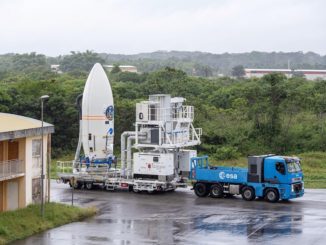
Viasat has modified an existing contract with Arianespace to launch one of the company’s next-generation broadband Internet satellites on Europe’s next-generation Ariane 6 rocket, rather than on-board an Ariane 5 launcher, officials announced Monday.
The agreement makes Viasat the first commercial company to commit to launch on the Ariane 64, the more powerful variant of the Ariane 6 rocket with four strap-on solid rocket boosters.
California-based Viasat is developed a new fleet of satellites to beam broadband Internet signals around the world from operating posts in geostationary orbit more than 22,000 miles (nearly 36,000 kilometers) over the equator.
The three new ViaSat 3 satellites are being built by Boeing, and Viasat has booked their launches with Arianespace, SpaceX and United Launch Alliance.
Viasat originally signed a contract with Arianespace in 2016 to launch one of the ViaSat 3 satellites on an Ariane 5 ECA rocket. The Ariane 6 rocket, which is scheduled for its first launch from French Guiana in 2020, will debut the new Vinci upper stage engine that can be reignited in space on missions lasting several hours, unlike the Ariane 5’s one-and-done cryogenic upper stage.
The new upper stage engine will allow the Ariane 6 rocket to place the ViaSat 3 payload into a “high-energy” geostationary transfer orbit closer to the spacecraft’s final operating location, allowing for a shorter transit using the satellite’s own propulsion system, and a faster entry into service, Viasat officials said.
The ViaSat 3 launch will use the Ariane 64 variant of the new European launcher, which is being designed and built by ArianeGroup, a joint venture between Airbus Defense and Space and Safran, with the support of European Space Agency funding. The Ariane 64, or A64, will be capable of carrying more than 25,350 pounds (11.5 metric tons) of cargo to geostationary transfer orbit, roughly 15 percent more than the Ariane 5’s capacity to the same orbit.
“We have a long-standing partnership with Arianespace, and trust their A64 launcher will allow Viasat to meet key business objectives, which include bringing high-speed, high-quality broadband connectivity to end-users, worldwide,” said Dave Ryan, president of space and commercial networks at Viasat, in a statement. “The A64 vehicle is a highly competitive launcher, and incorporates key features to ensure a more cost-effective, dependable ViaSat-3 spacecraft launch.”
The Ariane 6 will also come in a lighter variant, known as the Ariane 62, with two solid rocket boosters clustered around the launcher’s hydrogen-fueled core stage.
“We were honored that Viasat initially chose Arianespace for one of its ViaSat 3 launches, and has now evolved the program, enabling them to be the first commercial launch customer to commit to fly on our powerful Ariane 64 launcher,” said Stephane Israel, Arianespace’s CEO. “By moving to the A64 vehicle, we are confident we will demonstrate next-generation market adaptability — one that responds better to customer needs.”
The three ViaSat 3 satellites will cover the globe with Ka-band broadband service, with each spacecraft designed to provide 1 terabit per second of network capacity, according to Viasat.
The first of the new satellites will cover the Americas, followed by a second craft over Europe, Africa and the Middle East, and a third node over the Asia-Pacific region.
Viasat has not assigned specific satellites to the company’s roster of launch vehicles from Arianespace, SpaceX and ULA.
After signing the first ViaSat 3 launch contract with Arianespace in 2016, Viasat announced deals with ULA and SpaceX last year to send the other two ViaSat 3 spacecraft aloft on Atlas 5 and Falcon Heavy rockets from Cape Canaveral.
Viasat’s satellites currently in space provide Internet service over North America, the Caribbean and along trans-Atlantic airline routes. The company’s network will become global with the launch of the next three satellites.
In March, Arianespace announced that OneWeb — another competitor in the satellite broadband market — will be the customer on the Ariane 6’s inaugural launch in 2020. OneWeb is expected to launch around 30 small satellites into low Earth orbit on the first Ariane 6 mission, which will fly in the smaller Ariane 62 configuration.
Arianespace has also signed up the French government to launch an optical spy satellite on an Ariane 62 rocket, and ESA has a contract, on behalf of the European Commission, to launch four Galileo navigation satellites on a pair of Ariane 62 rockets.
Eutelsat, the Paris-based commercial communications satellite operator, also signed a multi-launch agreement with Arianespace last year, including provisions for an unspecified number of future Ariane 6 flights.
Email the author.
Follow Stephen Clark on Twitter: @StephenClark1.



